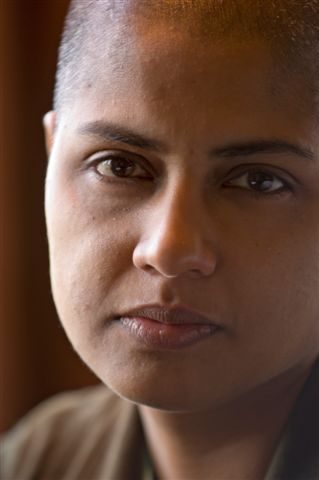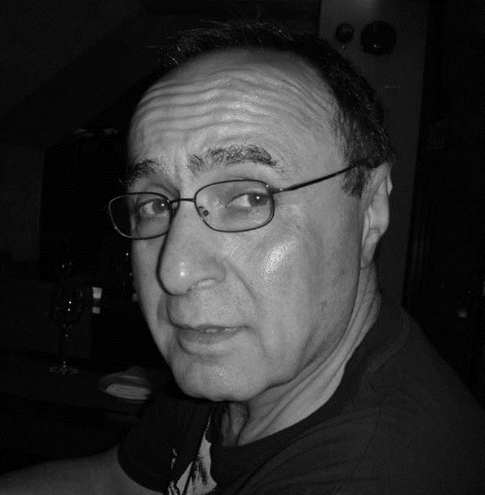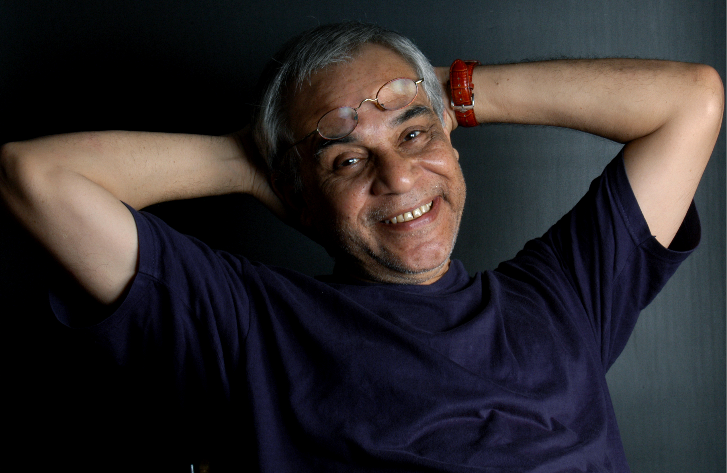 Mani Rao is the author of eight books of poetry, a translation of the Bhagavad Gita and a forthcoming translation of Kalidasa’s works. Her essays and poems have appeared in such journals as Fulcrum, Iowa Review, Meanjin, Tinfish, Wasafiri, Washington Review, West Coast Line, and Zoland Poetry, and in anthologies W W Norton’s Language for a New Century, Penguin’s 60 Indian Poets, and the Bloodaxe Book of Contemporary Indian Poets. She was a Visiting Fellow at the Iowa International Writing Program in 2005 and 2009, and the 2006 University of Iowa International Programs writer-in-residence. Translations of her poems have been published in Latin, Italian, Korean, Chinese, Arabic, French and German. Mani lives in North Carolina.
.
Mani Rao is the author of eight books of poetry, a translation of the Bhagavad Gita and a forthcoming translation of Kalidasa’s works. Her essays and poems have appeared in such journals as Fulcrum, Iowa Review, Meanjin, Tinfish, Wasafiri, Washington Review, West Coast Line, and Zoland Poetry, and in anthologies W W Norton’s Language for a New Century, Penguin’s 60 Indian Poets, and the Bloodaxe Book of Contemporary Indian Poets. She was a Visiting Fellow at the Iowa International Writing Program in 2005 and 2009, and the 2006 University of Iowa International Programs writer-in-residence. Translations of her poems have been published in Latin, Italian, Korean, Chinese, Arabic, French and German. Mani lives in North Carolina.
.
Lorine Niedecker Condens
This is a poem-essay on Lorine Niedecker using only words from her writing. Every word in the poem is footnoted for its source from her work. Many lines in the poem are made by combining bits of lines from her work, so sometimes a single line has many footnotes. The condensation technique is also in line with her own technique. I see the work as a kind of ventriloquism, or mediation, using her voice, to tell her story (the way I see it)....
 Catherine Wagner is the author of four books of poems and editor of an anthology, Not for Mothers Only; her work has been extensively anthologized and she is a frequently heard voice at poetry readings across the countryand in the UK. City Lights published Wagner’s latest book Nervous Device in 2012; it was one of 12 Notable Books for 2012 chosen by the Academy of American Poets and became a Small Press Distribution bestseller. Previous books include My New Job (Fence, 2009), Macular Hole (Fence, 2004) etc. Wagner’s anthology appearances include the recent Norton Anthology of Postmodern American Poetry, The Best American Erotic Poems, 1800 to the Present, etc. She is a professor of English, teaching on the MA program in Creative Writing at Miami University, Ohio.
Catherine Wagner is the author of four books of poems and editor of an anthology, Not for Mothers Only; her work has been extensively anthologized and she is a frequently heard voice at poetry readings across the countryand in the UK. City Lights published Wagner’s latest book Nervous Device in 2012; it was one of 12 Notable Books for 2012 chosen by the Academy of American Poets and became a Small Press Distribution bestseller. Previous books include My New Job (Fence, 2009), Macular Hole (Fence, 2004) etc. Wagner’s anthology appearances include the recent Norton Anthology of Postmodern American Poetry, The Best American Erotic Poems, 1800 to the Present, etc. She is a professor of English, teaching on the MA program in Creative Writing at Miami University, Ohio.
A Cornucopia Amendment
In 1993, while living in Baltimore and waiting tables, I had a fantasy about having sex with a man who lived on the street near Cross Street Market in Federal Hill, South Baltimore, an area now thoroughly gentrified but then in transition. The man had rotted teeth; his clothes were filthy, he smelled terrible, and he was very flirty. I started writing a sequence called “Hole in the Ground,”...
 Murat Nemet-Nejat is a poet, translator and essayist. He edited and largely translated Eda: A Contemporary Anthology of Turkish Poetry (2004), translated Orhan Veli, I, Orhan Veli (1989), Ece Ayhan, A Blind Cat Black and Orthodoxies (1997), Seyhan Erözçelik, Rosestrikes and Coffee Grinds (2010), Birhan Keskin, at the bifurcation/ they part/ Y/ why (2012). He is the author of "Questions of Accent" (1993), The Peripheral Space of Photography(2004) and, recently, the memoir/essay “Istanbul Noir” (2011) and the essay "The Structure of Escape": The Linearity of the Arc" (2012), the poems “steps” (2008), “Prelude” (2009), “I Did My Best Work During a Writer’s Block” (2009), “Disappearances” (2010) and “Alphabet Dialogues/Penis Monologues” (2010) and The Spiritual Life of Replicants (2012). He is presently on a collection of the Turkish poet Sami Baydar's poetry in English and on the long 7-part poem The Structure of Escape.
Murat Nemet-Nejat is a poet, translator and essayist. He edited and largely translated Eda: A Contemporary Anthology of Turkish Poetry (2004), translated Orhan Veli, I, Orhan Veli (1989), Ece Ayhan, A Blind Cat Black and Orthodoxies (1997), Seyhan Erözçelik, Rosestrikes and Coffee Grinds (2010), Birhan Keskin, at the bifurcation/ they part/ Y/ why (2012). He is the author of "Questions of Accent" (1993), The Peripheral Space of Photography(2004) and, recently, the memoir/essay “Istanbul Noir” (2011) and the essay "The Structure of Escape": The Linearity of the Arc" (2012), the poems “steps” (2008), “Prelude” (2009), “I Did My Best Work During a Writer’s Block” (2009), “Disappearances” (2010) and “Alphabet Dialogues/Penis Monologues” (2010) and The Spiritual Life of Replicants (2012). He is presently on a collection of the Turkish poet Sami Baydar's poetry in English and on the long 7-part poem The Structure of Escape.
The Sami Baydar Project: Painterly Space and Poems
Barely appreciated in his life time, Sami Baydar is one of the central and most elusive Turkish poets of the turn of the century. He died in 2012 at the age of fifty. His collected works Dünya İnancı (The World’s Belief) appeared in the same year. Baydar’s startling originality can be approached from two perspectives: a) thematically, his work is infused with a version of Turkish Sufism centered on the elimination of the ego through tears and suffering. The result is a radical melancholy (in Turkish called hüzün) which is on the verge of being ecstatic. The primary image is water,...
[ The Sami Baydar Project: Painterly Space and Poems]
 Priya Sarukkai Chabria is a poet, writer and translator. Recipient of the Indian Government’s Senior Fellowship to Outstanding Artists for Literature she studied the Rasa Theory of Aesthetics and edits the poetry page for Sangam House www.sangamhouse.org. Her books include two poetry collections, Dialogue & Other Poems (2005, Sahitya Akademi) and Not Springtime Yet (2009, HarperCollins Publishers), the novel The Other Garden (1995, Rupa&Co.) and the speculative fiction Generation 14 (2009, Penguin-Zubaan), Her work is published in numerous international journals such as Soundings (UK), South Asian Review (USA) Alphabet City (Canada), Post Road (USA), India International Centre , In Other Words The British Journal of Literary Translation , Southerly (Australia) etc. and anthologies including Language for a New Century Contemporary Poetry from The Middle East, Asia and Beyond (2008, WW Norton & Co. UK & USA), The Literary Review An International Journal of Contemporary Writing (2009, USA), The HarperCollins Book English Poetry (2012, India ) etc. She has presented her work at numerous international events and has co-curated two seminars for the Indian Academy of Literature. Forthcoming in 2013 are Immersions: Bombay/Mumbai with photographer Christopher Taylor(Niyogi Books), a book on Indian cinema (HarperCollins Publishers) and The Autobiography of a Goddess, translations of Tamil mystic Aandaal’s songs (Zubaan).
Priya Sarukkai Chabria is a poet, writer and translator. Recipient of the Indian Government’s Senior Fellowship to Outstanding Artists for Literature she studied the Rasa Theory of Aesthetics and edits the poetry page for Sangam House www.sangamhouse.org. Her books include two poetry collections, Dialogue & Other Poems (2005, Sahitya Akademi) and Not Springtime Yet (2009, HarperCollins Publishers), the novel The Other Garden (1995, Rupa&Co.) and the speculative fiction Generation 14 (2009, Penguin-Zubaan), Her work is published in numerous international journals such as Soundings (UK), South Asian Review (USA) Alphabet City (Canada), Post Road (USA), India International Centre , In Other Words The British Journal of Literary Translation , Southerly (Australia) etc. and anthologies including Language for a New Century Contemporary Poetry from The Middle East, Asia and Beyond (2008, WW Norton & Co. UK & USA), The Literary Review An International Journal of Contemporary Writing (2009, USA), The HarperCollins Book English Poetry (2012, India ) etc. She has presented her work at numerous international events and has co-curated two seminars for the Indian Academy of Literature. Forthcoming in 2013 are Immersions: Bombay/Mumbai with photographer Christopher Taylor(Niyogi Books), a book on Indian cinema (HarperCollins Publishers) and The Autobiography of a Goddess, translations of Tamil mystic Aandaal’s songs (Zubaan).
The Autobiography Of A Goddess Project
Aandaal’s songs are primarily seen as sacred texts, not poetry. Most often in translating sacred verse philosophical overtones tend to override the poetry. I see her as a poet divine. She composed in cen/Old Tamil, faithful to 2 BCE-to 2 CE Sangam era poetic conventions. Sangam means a gathering; the practitioners of old knew the rules and modes of interpreting such love poetry; coded allusiveness was the key. Besides the literal meaning, simultaneous parallel (ullari) and inset (eraichi) meanings needed to be prized out of each poem. Such poetry offers a riddling generosity of interpretative possibilities as each verse reveals layered, multiple configurations of meanings...
[ The Autobiography Of A Goddess Project]
 Dhritiman Chaterji is one of India's most versatile and respected actors. His acting career began in 1970 as the protagonist of Satyajit Ray's Pratidwandi (The Adversary). Selective about films, he never plunged into a hectic life of movie-acting but carefully chose genres, roles and styles giving performances that cover a wide range of cinema - from arthouse and experimental cinema to short films, documentaries and even mainstream Bollywood blockbusters. Dhritiman has also worked in English language films with well-known filmmakers such as Deepa Mehta, Jane Campion etc. He has received numerous acting awards in India and has been on the Jury of the Indian National film Awards. Dhritiman pursues a parallel career in stage and voice acting, advertising, social communications and documentary filmmaking. He is also an amateur photographer, a voracious reader, occasional writer, anchor and reciter.
Dhritiman Chaterji is one of India's most versatile and respected actors. His acting career began in 1970 as the protagonist of Satyajit Ray's Pratidwandi (The Adversary). Selective about films, he never plunged into a hectic life of movie-acting but carefully chose genres, roles and styles giving performances that cover a wide range of cinema - from arthouse and experimental cinema to short films, documentaries and even mainstream Bollywood blockbusters. Dhritiman has also worked in English language films with well-known filmmakers such as Deepa Mehta, Jane Campion etc. He has received numerous acting awards in India and has been on the Jury of the Indian National film Awards. Dhritiman pursues a parallel career in stage and voice acting, advertising, social communications and documentary filmmaking. He is also an amateur photographer, a voracious reader, occasional writer, anchor and reciter.
|
|
I N T E R V I E W: Poetry, Cinema and their Interstices
In Part I of a spooling interview with Aryanil Mukherjee, which centers around the crosswinds going back and forth between cinema and poetry, famed actor Dhritiman Chaterji talks about the interstices of poetry and cinema, his films, his directors - Satyajit Ray, Mrinal Sen, Aparna Sen and more ...
[ I N T E R V I E W with Aryanil Mukherjee]